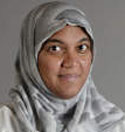Discouraging Muslim Women, The ‘Hidden Figures’ Of Islam, from Pursuing Education, Is Like Pre-Islamic Practice of Burying Baby Girls Alive

By Sheema Khan
March 07, 2020
On Feb. 24, Katherine Johnson – the esteemed mathematician who was part of an exclusive group of scientists at NASA’s Flight Research Division, where she used her mind, a slide rule and pencil to calculate flight paths for the Apollo 11 moon mission in 1969 – passed away at the age of 101. And if you know her story – as well as that of her NASA cohort of brilliant African-American female mathematicians – it may be because of the 2016 film Hidden Figures, based on the book by Margot Lee Shetterly.
That film was a revelation to much of the American public. It shattered many stereotypes and showcased the intellectual talents and resilience of women who wouldn’t let institutionalized racism and segregation get in the way of achieving excellence.
Those themes are universal, though. Ground-breaking accomplishments by women have always occurred. We just need to dig deep enough in history to find these gems. And Muslim women are just starting to get their similar due.
Thanks to the painstaking research of Islamic scholar Mohammad Akram Nadwi, the dean of Cambridge Islamic College, the stories of accomplished Muslim female scholars, jurists and judges have been unearthed. Over the past 20 years, Mr. Nadwi’s research of biographical dictionaries, classical texts, madrasa chronicles and letters has led to a listing of about 10,000 Muslim women who have contributed toward various fields of Islamic knowledge over a period of 10 centuries.
Not only is the sheer number impressive, but so is the manner in which these women operated: Many were encouraged by their fathers at an early age to acquire knowledge, and many travelled to seek deeper understanding of Islamic sciences. They sat in study circles – with men – at the renowned centres of learning, debating and questioning alongside their male counterparts. And they taught their own study circles to men and women alike. Some were so revered that students came from near and far to absorb their wisdom. They approved certifications of learning and provided fatwas (non-binding religious opinions); as judges, they delivered important rulings.
A few notable examples include Aisha, the youngest wife of Prophet Mohammed, who was known for her expertise in the Koran, Arabic literature, history, general medicine and juridical matters in Islam. She was a primary source of authentic hadith, or traditions of the Prophet, which form part of the foundation of Sunni Islam. Umm al-Darda was a 7th-century scholar who taught students in the mosques of Damascus and Jerusalem, including the caliph Abd al-Malik ibn Marwan. She was considered among the best traditionalists of her time. “I’ve tried to worship Allah in every way,” she wrote, “but I’ve never found a better one than sitting around debating with other scholars.” And one of the greatest was the 8th-century scholar Fatima al-Batayahiyyah, who taught in Damascus. During the Hajj, leading male scholars flocked to her lectures. She later moved to Medina, where she taught students in the revered mosque of the Prophet. When she tired, she rested her head on the grave of Mohammed. Fatimah bint Mohammed al Samarqandi, a 12th-century jurist, advised her more famous husband, ‘Ala’ al-Din al-Kasani, on how to issue his fatwas; she was also a mentor to Salahuddin.
These are but a few of the thousand luminaries found by Mr. Nadwi, a classically trained Islamic scholar. Initially, he thought he would find 20 or 30 women; his compilation now fills 40 volumes. While a 400-page preface (Al-Muhaddithat: The Women Scholars in Islam) has been published, the remainder sits on a hard drive, waiting for a publisher. Given the far-reaching importance of Mr. Nadwi’s work, surely a Muslim country or UNESCO can help disseminate it.
This research provides a stark contrast to contemporary practice in parts of the Muslim world. Some mosques, including ones here in Canada, forbid women. Rarely do Muslim women give lectures to their own communities. And the idea of women being intellectually on par with (or superior to) men is laughable in many quarters. Muslim women have a long way to go to reclaim their rightful place. Even his ground-breaking research will not change much, laments Mr. Nadwi, until Muslim men have respect for women – respect that starts in the home. He’s seen too much family violence in Britain, India and Pakistan. He’s highly critical of those who discourage or deny women from pursuing education, comparing it to the pre-Islamic practice of burying baby girls alive.
Muslims have just begun to discover our own “hidden figures” and there are many more yet to find. If we fail to deal with the present-day sexism that has eroded the egalitarian nature of our own historical communities, this excavation becomes all the more difficult.
Sheema Khan is the author of “Of Hockey and Hijab”: Reflections of a Canadian Muslim Woman
Original Headline: To unearth the ‘hidden figures’ of Islam, sexism against Muslim women must end
Source: The Globe and Mail
URL: https://newageislam.com/islam-women-feminism/discouraging-muslim-women,-‘hidden-figures’/d/121304
